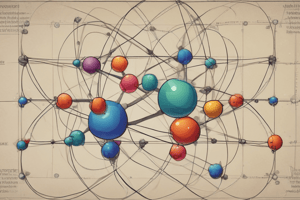Podcast
Questions and Answers
What is represented by the stoichiometric coefficients in a chemical reaction?
What is represented by the stoichiometric coefficients in a chemical reaction?
- The phase states of the substances involved
- The pressure inside the reaction vessel
- The relative amounts of reactants and products (correct)
- The temperature of the reaction
Which of the following correctly matches the compound state symbol with its meaning?
Which of the following correctly matches the compound state symbol with its meaning?
- (g) for gas phase only
- (l) for liquid but not for aqueous solutions
- (aq) for aqueous solution (correct)
- (s) for solution in a solid form
Which of these is an example of a combination reaction?
Which of these is an example of a combination reaction?
- AB △→ A + B
- A + C → B
- AB + CD → AC + BD
- A + B → AB (correct)
What does the empirical formula represent?
What does the empirical formula represent?
Which reaction type involves a compound being decomposed into two or more substances?
Which reaction type involves a compound being decomposed into two or more substances?
Which of the following represents a pattern for combination reactions?
Which of the following represents a pattern for combination reactions?
What does Avogadro's Number represent?
What does Avogadro's Number represent?
In a decomposition reaction, why are some reactants not fully consumed?
In a decomposition reaction, why are some reactants not fully consumed?
What is the main purpose of Lewis dot symbols?
What is the main purpose of Lewis dot symbols?
Which of the following describes isoelectronic species?
Which of the following describes isoelectronic species?
According to the octet rule, what is the goal of an atom in chemical bonding?
According to the octet rule, what is the goal of an atom in chemical bonding?
Which of the following correctly describes an expanded octet?
Which of the following correctly describes an expanded octet?
Which notation describes a simplified version of an electron configuration using the nearest noble gas?
Which notation describes a simplified version of an electron configuration using the nearest noble gas?
What is a common characteristic of elements with an incomplete octet?
What is a common characteristic of elements with an incomplete octet?
What can a chemical bond be formed by?
What can a chemical bond be formed by?
Which statement about valence electron configuration is true?
Which statement about valence electron configuration is true?
What is the implication of a stable system as described by Le Chatelier's Principle?
What is the implication of a stable system as described by Le Chatelier's Principle?
What happens to the equilibrium position when the concentration of a reactant is increased?
What happens to the equilibrium position when the concentration of a reactant is increased?
Which of the following represents a condition leading to unstable nuclei?
Which of the following represents a condition leading to unstable nuclei?
What is the significance of the 'magic numbers' of protons and neutrons?
What is the significance of the 'magic numbers' of protons and neutrons?
How does a decrease in substance concentration affect equilibrium?
How does a decrease in substance concentration affect equilibrium?
Which statement best describes the neutron to proton ratio for a stable nucleus?
Which statement best describes the neutron to proton ratio for a stable nucleus?
In the context of radioactive decay, what is a characteristic feature of unstable isotopes?
In the context of radioactive decay, what is a characteristic feature of unstable isotopes?
What does an equilibrium constant (Kc) represent in a stable system?
What does an equilibrium constant (Kc) represent in a stable system?
What is the relationship between the number of protons and the number of electrons in a neutral atom?
What is the relationship between the number of protons and the number of electrons in a neutral atom?
Who is known as the 'Father of Modern Chemistry'?
Who is known as the 'Father of Modern Chemistry'?
What does the atomic property 'ionization energy' refer to?
What does the atomic property 'ionization energy' refer to?
Which of the following correctly describes 'groups' in the periodic table?
Which of the following correctly describes 'groups' in the periodic table?
What did Robert Boyle contribute to the understanding of elements?
What did Robert Boyle contribute to the understanding of elements?
What is the definition of 'reactivity' in terms of atomic properties?
What is the definition of 'reactivity' in terms of atomic properties?
In the periodic table, what do the 'periods' represent?
In the periodic table, what do the 'periods' represent?
What is meant by 'atomic size'?
What is meant by 'atomic size'?
What does Rydberg’s Equation quantify?
What does Rydberg’s Equation quantify?
Which quantum number describes the shape of orbitals?
Which quantum number describes the shape of orbitals?
What is the relationship between kinetic energy and the velocity of an electron as expressed by the equation $KE = \frac{1}{2}mv^2$?
What is the relationship between kinetic energy and the velocity of an electron as expressed by the equation $KE = \frac{1}{2}mv^2$?
What does the Spin quantum number indicate about electrons?
What does the Spin quantum number indicate about electrons?
In the context of the photoelectric effect, what is the work function?
In the context of the photoelectric effect, what is the work function?
According to the Aufbau Principle, what is the order of filling electron orbitals?
According to the Aufbau Principle, what is the order of filling electron orbitals?
What does quantum mechanical model assist in determining?
What does quantum mechanical model assist in determining?
What does the maximum number of electrons in a shell formula $2n^2$ represent?
What does the maximum number of electrons in a shell formula $2n^2$ represent?
How does Louis de Broglie's hypothesis relate to electrons?
How does Louis de Broglie's hypothesis relate to electrons?
What do nodes in electron probability distributions represent?
What do nodes in electron probability distributions represent?
How is the total energy of incident light represented in the equation $E_{Total} = \phi + KE$?
How is the total energy of incident light represented in the equation $E_{Total} = \phi + KE$?
What does the magnetic quantum number determine?
What does the magnetic quantum number determine?
Which of the following transitions would produce the least energy, according to the Hydrogen Spectrum Series?
Which of the following transitions would produce the least energy, according to the Hydrogen Spectrum Series?
Flashcards are hidden until you start studying
Study Notes
Atomic Structure and Properties
- Protons define the atomic number, while electrons equal protons in neutral atoms. Neutrons are calculated by subtracting atomic number from the mass number.
- Robert Boyle defined elements as pure substances that cannot be decomposed further, establishing a foundation for modern chemistry.
- Antoine Lavoisier, the "Father of Modern Chemistry," initiated a standardized naming system, identified gases like oxygen and hydrogen, and formulated the Law of Conservation of Mass.
- Atomic properties include metallic property (ability of an atom to donate an electron), atomic size (distance from the nucleus to the valence electron), reactivity (tendency to react), and ionization energy.
Periodic Table Organization
- Groups: Vertical columns group elements with similar valence electrons and chemical properties.
- Periods: Horizontal rows denote elements with the same number of electron shells.
Rydberg’s Equation
- Used to quantify wavelengths during electron transitions from excited to ground states.
- The equation is expressed as ( \frac{1}{\lambda} = R_H \left( \frac{1}{n_f^2} - \frac{1}{n_i^2} \right) ).
Electron Wave Theory
- Louis de Broglie proposed that electrons exhibit wave-like behavior, impacting their representation in quantum mechanics.
Quantum Mechanical Model
- Models describe electron positions as probabilities in 3D space, characterized by quantum numbers:
- Principal (n): main energy level,
- Azimuthal (l): shape of orbitals,
- Magnetic (m): orbital orientation,
- Spin (s): electron spin direction.
Atomic Spectrum of Hydrogen
- The emission spectrum results from atom excitation followed by photon release, observed in the Hydrogen Spectrum Series.
Light as a Particle
- Albert Einstein's photoelectric effect demonstrated that light can eject electrons from metals when photons strike the surface.
Kinetic and Work Function Energy
- Kinetic Energy (KE) is the energy driving electron ejection given by ( KE = \frac{1}{2} mv^2 ).
- Work Function (φ) is the minimum energy needed to remove an electron, represented by ( φ = h f_0 ).
Electron Configuration
- Electron configuration denotes how electrons are arranged in atomic orbitals, following principles like Aufbau (building from the lowest to highest energy).
- Valence electron configuration includes electrons at the highest energy level.
Chemical Bonds
- Chemical bonds arise from electron transfer or sharing to achieve stable electronic configurations.
- Mole: A mole equals Avogadro’s Number (approximately ( 6.022 \times 10^{23} )).
Types of Chemical Reactions
- Combination Reaction: Two or more reactants form one product (A + B → AB).
- Decomposition Reaction: A single compound breaks down into two or more substances (AB → A + B).
Le Chatelier’s Principle
- Describes system shifts in response to changes in concentration, pressure, or temperature, aimed at re-establishing equilibrium conditions.
Radioactive Decay
- Stability in nuclear reactions is influenced by the neutron-to-proton ratio, with stable nuclei having certain "magic numbers."
- Types of radioactive decay include alpha, beta, and gamma decay.
Studying That Suits You
Use AI to generate personalized quizzes and flashcards to suit your learning preferences.




